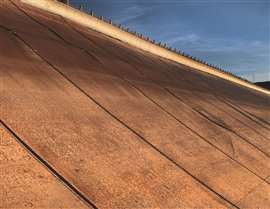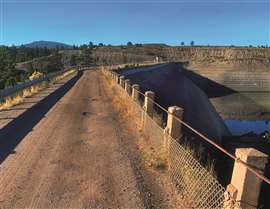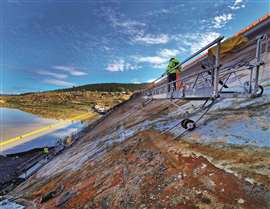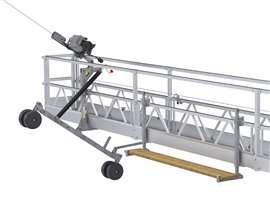Bee Access takes home top honor for suspended access solution
30 July 2024
The El Vado Dam, located in northern New Mexico on the southeast corner of the El Vado Lake, was built between 1933-1935 and feeds into the Rio Chama River.
 Overview of the El Vado Dam at the beginning of the restoration project. (Photo: Bee Access)
Overview of the El Vado Dam at the beginning of the restoration project. (Photo: Bee Access)
The 230-foot-tall, 1,326-foot-long dam holds 196,500 acre-feet of water. The embankment of the dam consists of rolled gravel fill with a steel membrane on the lakeside. The dam was rehabilitated by the Bureau of Reclamation in 1954-1955, however, the reservoir’s water storage in recent years was restricted due to structural concerns identified by the Bureau. Therefore, it was determined that the dam needed structural modifications to prolong its lifespan.
In August 2021, the Bureau of Reclamation awarded the contract to Carpi USA, Inc. for the first phase of structural modifications which started in March 2022.
The first phase of the seepage reduction modification project included the installation of Carpi’s SIBELON geomembrane on the upstream portion of the dam. This system is designed to stop leakage and provide protection to the face of the dam. To install the geomembrane, Capri called upon Bee Access to provide the best access solutions for the challenging terrain imposed by the near century-old dam surface.
El Vado Dam project summaryWith a project value of $32 million, Bee Access provided modular platform equipment that was accompanied by custom rigging and platform accessories (stirrups, porches, welding kits and anchors) to provide maximum access to the surface of the El Vado Dam. The weathered and aged dam produced numerous challenges for Bee Access and project partner Carpi USA, including:
The innovative engineering and manufacturing speed of Bee Access, along with the project coordination and installation expertise from Carpi USA, allowed the project to be on time and on budget. More than a year later, Bee Access says the project continues to provide a safe solution for the rehabilitation of the El Vado Dam. The project is expected to be completed by the end of the year in 2024. |
After reviewing the installation requirements provided by Carpi, Bee Access determine that the following access equipment and accessories would be required:
- 22 straight modular platforms ranging from 20 to 40 feet with a total length of over 1,100 feet supported by 44 custom incline stirrups
- The slope of the dam was approximately 33 degrees
- The existing metal membrane had large protrusions up to 12 inches in height
- The hoist mount on the incline stirrup needed to be elevated and independently rotational, allowing the platform to be launched from the limited space on top of the dam (utilizing a spreader bar)
- Platform accessories
- A fall restraint system was required to allow workers full travel from one platform to another without the use of independent lifelines
- 88 custom adjustable porch brackets to provide workers close access to the dam’s surface (2 – porches per platform)
- Platform welding protection to prevent electrical shock hazards
- 44 tieback anchor plates with dual rigging points
- The platform required a double-line rigging system to support the fall restraint system
- Anchor plates were secured to embedded HSS tubes provided by the Nicholson Construction Company
- Rigging lines needed to be buried underneath the access road on top of the dam and go over the edge of the dam
Ground-breaking suspended access designs
 Close-up example of the uneven terrain that the platforms would need to traverse over. (Photo: Bee Access)
Close-up example of the uneven terrain that the platforms would need to traverse over. (Photo: Bee Access)
The first and primary challenge that the dam presented was how to safely and easily gain close access to its inclined surface. The use of suspended platforms on inclined surfaces is not a new concept, however, the engineering team at Bee Access faced multiple obstacles, including large craters and bulges, making it difficult for the standard incline stirrup to traverse over.
Each suspension line would also have to pass over a wave guard at the top of the dam, which would place the platform’s hoist significantly further away from the working surface than normal.
In order to gain the close access required and work around the obstacles, Bee Access was tasked with creating a newly designed incline stirrup that could adapt to these challenges.
The innovative design featured larger rugged flat-free tires that could provide ground clearance of up to 13 inches. Along with larger tires, the hoist mount was relocated to the top of the stirrup, closer to the platform and guardrail.
 The narrow access road at the top of the dam where the platforms would be deployed from and the rigging would be set up. (Photo: Bee Access)
The narrow access road at the top of the dam where the platforms would be deployed from and the rigging would be set up. (Photo: Bee Access)
The redesigned hoist mount allowed the hoist to pivot independently from the angle that the wheels were traveling, alleviating added stress on the rigging. The new stirrup also included an upgraded, easily accessible jack assembly that could accommodate inclined surfaces ranging from 20 to 80 degrees without the help of additional hardware extensions that standard incline stirrups use.
The platform then could maneuver over the inclined surface of the dam, the next obstacle was gaining close access to the surface itself. Due to the inconsistency of the dam’s surface, standard platform porches would not be sufficient to provide the access needed.
Custom porch brackets were designed so that the height, length and location of the porch could be adjusted at any point during the installation process. The porch brackets mount onto the midrail at the front of the platform, while wood planks and/or Aluma planks can be used to construct the deck for the porch.
 One fully assembled 46ft platform supported by newly designed Bee Access incline stirrups. (Photo: Bee Access)
One fully assembled 46ft platform supported by newly designed Bee Access incline stirrups. (Photo: Bee Access)
Since the porch brackets mount around the frames of the midrail, workers can assemble the porch in various locations along the length of the platform as needed. The brackets also have the ability to be adjusted vertically to position the deck at different distances from the surface of the dam.
Sparks a-flyin’
Welding was also a critical part of the dam restoration and installation of the membrane; so a special welding kit was created to protect the workers from potential electrical shock. Since the wire rope would be in contact with the metal surface being welded on the dam, the wire rope along with the hoist needed to be insulated from the platform.
To isolate the platform away from the welding surface, both the primary and secondary suspension cable needed to be covered with insulation to prevent unwanted contact between the suspension lines and the platform.
The connection between the hoist and the stirrup was also insulated to protect from the transfer of current through the hoist. These series of precautions are necessary to prevent the electrical current from traveling back to the platform, causing injury or even death.
Suspended disbelief
The next challenge that the project posed was the lack of tie-off points to suspend the platforms. Carpi recruited the Nicholson Construction Company to design and install the embedded post which could be used as tie-off points for the platforms. The post would be coupled with Bee Access Tieback Anchor Plates with dual rigging points to connect the primary and secondary suspension lines to the embedded post.
 Detail of the wire rope insulation used with the welding kit to shield the hoist and wire rope from contacting the platform. (Photo: Bee Access)
Detail of the wire rope insulation used with the welding kit to shield the hoist and wire rope from contacting the platform. (Photo: Bee Access)
 Detailed rendering of the new incline stirrup and custom porch brackets mounted on a platform, designed specifically for the El Vado Dam project (Note: only one wire rope is shown in the rendering, however two were used per hoist for the project.) (Photo: Bee Access)
Detailed rendering of the new incline stirrup and custom porch brackets mounted on a platform, designed specifically for the El Vado Dam project (Note: only one wire rope is shown in the rendering, however two were used per hoist for the project.) (Photo: Bee Access)
Once the posts were cast into position, trenches were dug at each rigging location from the post to the edge of the wave guard. The suspension lines were reeved through a protective casing and then laid over the wave guard. After the lines were in place, the protective casing could be buried, allowing for continuous access across the road at the top of the dam even during operation. The project called for a total of 44 anchors to be cast at the top of the dam to provide support for all 22 platforms.
Deploying and positioning the platforms into place would also prove to be difficult due to the limited access at the top of the dam and the presence of the wave guard.
Bee Access designed a spreader bar that could be attached to support the full length of the platform. Using the combination of a crane and the spreader bar, the platforms were assembled on the road above the dam and deployed one by one and set into place near the wave guard at the top of the dam. 22 platforms were constructed and deployed side by side to provide over 1,100 feet of access to the surface of the dam.
|
For its work on the El Vado Dam, Bee Access took home the Scaffold & Access Industry Association’s (SAIA) Suspended Access Project of the Year Award. The award is presented to a Scaffold & Access Industry Association member company where suspended access was utilized to:
For more information on the SAIA, or the awards, visit www.saiaonline.org. |
STAY CONNECTED



Receive the information you need when you need it through our world-leading magazines, newsletters and daily briefings.
CONNECT WITH THE TEAM






